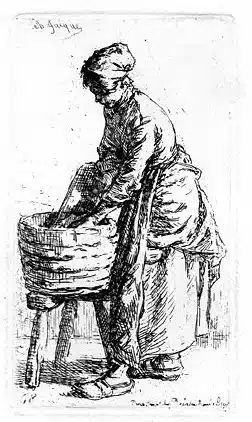Dishwashing, as a by-product of food preparation and consumption, has been an important part of our lives since the beginning of human civilization.
Have you ever wondered how dishes were washed in eras when modern dishwashers and detergents were unavailable?
In the earliest times, the first method of washing dishes was presumably to rub them clean with sand and wash them in clean water. In ancient Rome, in addition to water and sand, other abrasives such as cuttlefish bone and horsetail were also introduced. In the Middle Ages, chemicals such as rhubarb juice were used for washing kitchen utensils. Dishes made of delicate materials were washed with soft textiles. Washing dishes with running water was introduced during the Renaissance. Later, in the 19th century, the use of warm water and soap was already common for keeping kitchen utensils clean. Then, during the industrial revolution, the dishwasher was invented. The 20th century brought the development and mass production of dishwashing detergents and electric dishwashers, which thus became available to every household.
A brief history of the development of dishwashing techniques
The Ancient Era
Soap was known and used in ancient Babylon around 5,000 years ago. Based on archaeological findings, Babylonian soap was made from fat and ash. Similar soaps were known in other ancient cultures, such as Egypt and Rome.
In the 8th century BC, Homer wrote in the Odyssey that servants wiped the dining tables with sponges. The sea sponge was already used in ancient times for personal hygiene purposes. Later, the crusaders brought the sponge to Europe.
There is no evidence that soap and sponges were used for washing dishes in ancient times, but these materials were the forerunners of modern detergents and sponges.

Middle Ages
In medieval Europe, there was a decline in hygiene habits, which opened the door to deadly epidemics. In Asian cultures, however, hygiene remained at a high standard.
The Crusaders brought metal cauldrons from the Middle East to Europe in the 1300s, which local craftsmen began to copy. Initially, food was cooked in these large cauldrons hung over an open fire, then water was heated for bathing and washing dishes.
Later, the three-legged cauldron, which was used on the kitchen stove, came into use in family houses.
Find out if it is safe to wash dishes solely with water.
Dishwashing in the Renaissance

During the Renaissance, running water began to be used for washing dishes, in a dedicated niche separate from the kitchen.
19th-century dishwashing techniques
In the book American Woman’s Home published by J.B. Ford and Company in 1896, we find practical guidelines for washing dishes, which recommended the use of water and hard soap.
According to the author’s recommendations, the first stage of washing dishes was scraping the leftovers from the plates, by selectively categorizing the waste.
The second phase involved washing the delicate dishes, rinsing them, and wiping them dry. In the third stage, the author recommends using warm water to wash greasy utensils, forks, and knives.
In the fourth stage, the milk pots, pans, and buckets were washed in clean soapy water.
19th-century dishwashing tools included dishmops, abrasive powders, wire scrapers, and sand for washing dishes, along with warm, soapy water.
Chemicals such as lemon and salt were used to polish metal vessels.
The invention of the dishwasher
In the 1850s, dishwasher patents began to appear. The first mechanical dishwasher, which is the closest thing to today’s modern ones, was invented by Josephine Garis Cochrane.
Cochrane drew a blueprint for the dishwasher, which she built with the help of an engineer. After achieving success at the Chicago World’s Fair in 1883, Cochrane patented her invention in 1900. After Josephine’s death, her heirs sold the company to the founders of KitchenAid.
At the end of the 1800s, the first detergent for dishwashers appeared on the market.
Dishwashing in the 20th century
In the 1930s, electric dishwashers replaced mechanical ones.
In 1937, the German scientist Otto Bayer invented the polyurethane sponge, which was similar to the sea sponges used up until that time. In the 1940s, dishwashing sponges made of artificial material were already available on the market.
During World War II, the fats and oils used in the production of cleaning agents became difficult to obtain, and the production of synthetic detergents began. After the war, the production of liquid dishwashing detergents began, both for machine and hand washing.
In the 1980s and 90s, the production of phosphate-free, environmentally friendly, and concentrated dishwashing detergents began.
New-generation, energy-saving dishwashers are now standard equipment in many households. They take a big burden off our shoulders, and we save time and water by using them. Therefore, in my opinion, it is worth investing in a dishwasher.
Final thoughts
We have modern tools, detergents, and dishwashers available to keep our dishes clean. The oldest method of washing dishes was using water and sand.
In ancient times, in addition to sand, plants and fish bones began to be used to clean kitchen equipment, and in the Middle Ages, the first chemical cleaning agents appeared in the form of vegetable juices.
During the Renaissance, dishes were washed under running water, and in the 19th century, the use of soap and warm water was recommended. The dishwasher was invented during the industrial revolution.
In the 20th century, the production and development of synthetic detergents used for hand and machine dishwashing began. Towards the end of the 20th century, phosphate-free detergents appeared, which were more environmentally friendly.
This was, in short, the history of dishwashing from ancient times to the present day. How will dishwashing develop in the future?
Source: ENCYCLOPEDIA OF KITCHEN HISTORY by Mary Ellen Snodgrass

